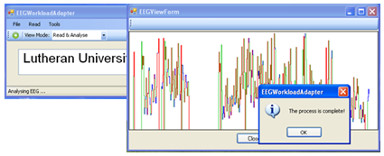
A Tool for Mental Workload Evaluation and Adaptation short paper
This paper studies the use of mental workload patterns measured from electroencephalographic (EEG) signals in the adaptation of reading activities. Mental workload is associated with the feeling of (dis) comfort of users, based on the assumption that a higher mental workload involves a greater discomfort.
There is increasing interest in the use of physiological signals for the design of interactive systems, reinforcing the link between the application behavior and the user’s emotional and mental states.
Reading processes are pervasive in visual user interfaces. Previous work has integrated EEG signals in prototypical applications, designed to analyze reading tasks, and tried to identify the most relevant features for discriminating reading and non-reading mental states. In this paper we address the possibility of adjusting the reading conditions to the user’s mental state.
We start by analyzing the correlation between the mental workload and the variation of some relevant HCI textual aspects, such as text size. Then we developed applications that analyze the user's mental workload and adjust the speed of text presentation to the user's mental load. The experiments have been performed in a conventional HCI lab, with non clinical EEG equipment and setup. This is an explicit and design condition, as it targets ecological reading situations.